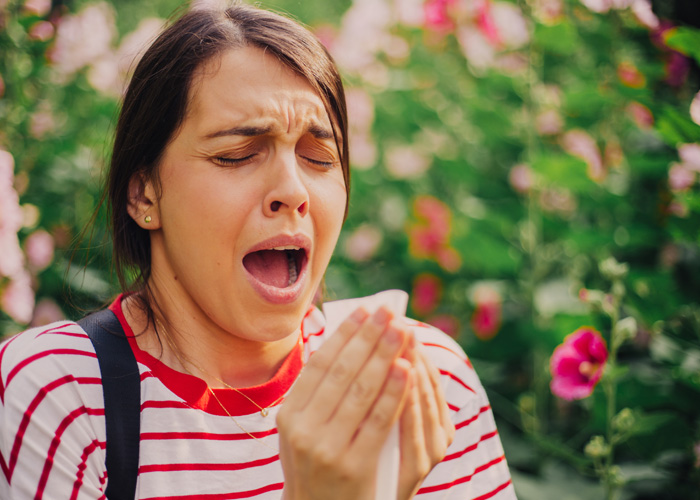Be prepared for the sneezing season
Record learning outcomes
Hay fever has a serious effect on quality of life for Britain’s 18 million sufferers. Take a look at the latest advances in pollen forecasting and what this season might have in store, plus the best advice to pass on to your customers
There are 18 million hay fever sufferers in Britain. Ten to15 per cent of children and 26 per cent of adults are affected,according to the British Society for Allergy and Clinical Immunology (BSACI). Prevalence has trebled over the past 20 years, says Allergy UK. It’s often dismissed as a minor complaint, but allergic rhinitis can have a serious impact on quality of life, affecting sleep, concentration, work and school attendance. It’s also a risk factor for the development of asthma, say the BSACI and Allergy UK. Between 74 and 81 per cent of people with asthma report rhinitis symptoms.
Allergic rhinitis affects asthma control and is a strong risk factor for new-onset asthma. A family history of allergy is the most important factor in development of hay fever. Other factors include living in an urban environment and less exposure to infectious diseases in early life.
Allergic rhinitis occurs when the body makes allergic antibodies to normally harmless allergens such as pollen from grass and trees. In people sensitive to these allergens, exposure causes the release of histamine from cells in the nose, eyes and airways, which causes hay fever symptoms.
According to the Met Office, climate change is having an impact on the UK pollen season. Changes in temperature and rainfall mean it could be longer and more severe in the future. Pharmacy staff can help customers to manage their symptoms and recommend the most effective treatments to minimise the impact of hay fever on their daily lives.
“Community pharmacists are well placed to provide people living with allergy with reliable, accurate and up-to-date advice and information about allergic disease,” says a spokesperson at Allergy UK. “Pharmacists should provide this information on a case by case basis, according to individual needs.”
Naresh Rallmil, service development pharmacist at Numark, says: “Pharmacy is well positioned to support customers with advice and an extensive product range that may not be available in other retailers. Pharmacy can offer guidance for customers to help mange symptoms and provide one-to-one professional support around choosing theright products for their needs and practical advice around avoiding allergens.”
Pharmacies, unlike supermarkets, can offer sufferers tailored advice and support. “You can offer advice focused on the customer’s individual symptoms and allergens, and their preferences on medication,” says Simon Mollart, OTC commercial manager for AAH Pharmaceuticals. “You can also offer tips on how to avoid pollen.”
All about pollen
Pollen is the structure that is used to transport male DNA to the female part of a flower. The outer wall of the pollen grain, the exine, is made of a tough substance called sporopollenin. The inner layer is made of cellulose. The grains are tiny, about 15 to 100 microns, and a tiny pinch of pollen powder contains thousands of pollen grains.
There are many different types of pollen, but some are particularly known for causing allergies. Grass pollen affects about 95 per cent of all sufferers and birch tree pollen affects 20 per cent. Oak tree, plane tree and nettle pollen are also common allergen sources. There are about 15 pollen species in the UK that are especially allergenic, says the National Pollen and Aerobiology Research Unit at the University of Worcester.
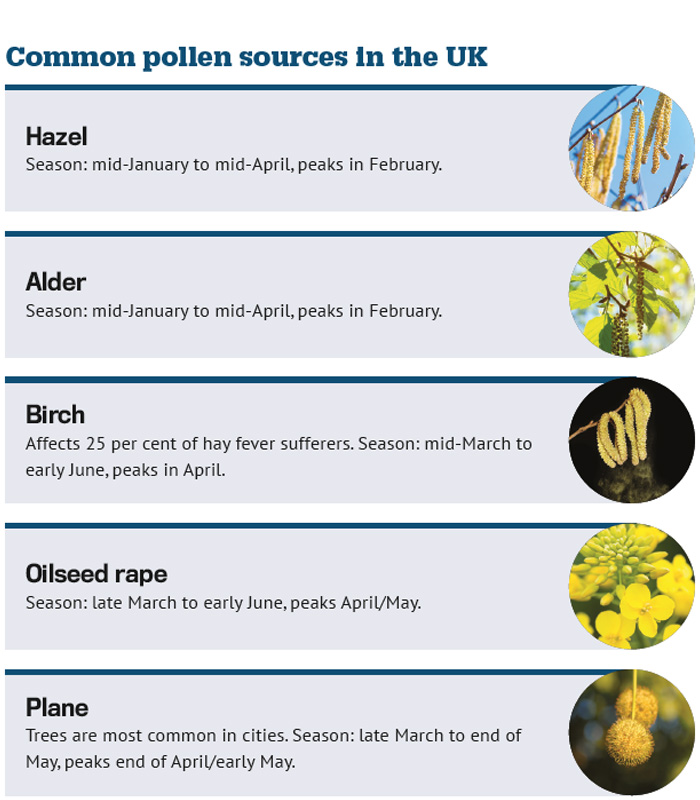
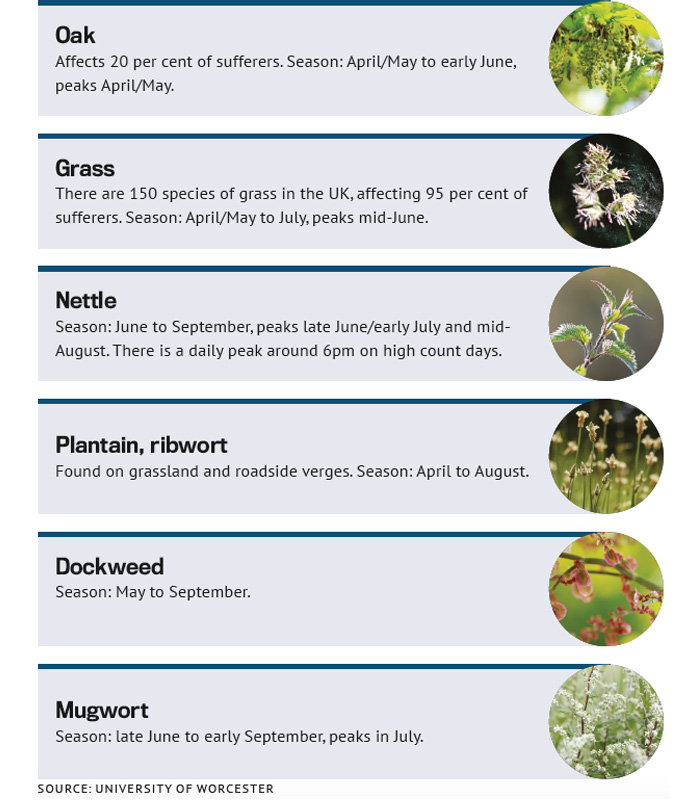
The pollen count is the amount of pollen per cubic metre of air in the past 24 hours
The pollen count forecast
The pollen count is the amount of pollen per cubic metre of air in the past 24 hours. When combined with weather conditions, this makes up the pollen forecast. There are monitoring sites across the UK, which measure pollen between March and September. A daily pollen forecast is generated by the Met Office and the National Pollen and Aerobiology Research Unit. Pollen is collected using a Burkard trap. Inside the trap, a spindle wrapped in sticky paper rotates and, as air flows through the trap, the pollen particles stick to the paper. These are then counted, using a microscope.
Hay fever symptoms normally appear when the pollen count exceeds 50. A grass pollen count of 50 to 150 grains per cubic metre is a high count. A birch pollen count of 81 to 200 grains is a high count.
The weather and pollen
Rain causes a decrease in pollen concentration in the air, says the Met Office. Early, heavy and prolonged rain will keep pollen counts low all day, while rain in the afternoon has less impact.
Temperature is also important. For grass, a maximum temperature of 18 to 28C can give a high count if it’s a dry day with low humidity and a gentle breeze. Trees prefer a temperature of 13 to 15C. If the temperature rises above 28C, all pollen levels drop. Sunlight is important for pollen production too. A spell of cloudy weather means plants produce less pollen.
Intermittent wet days over the spring and summer months tend to produce a more severe season. A hot, dry summer means that grass stops producing pollen, so there is a lower count.
Impact of location
The hay fever season starts at different times, depending on where you live. In the north of the UK, the season starts a couple of weeks later and is shorter because there is less pollen. Urban areas have lower counts than the countryside and inland locations have higher counts than coastal areas.
The tree pollen season this year will be mild to average in severity, compared with last year’s season, which was exceptionally severe
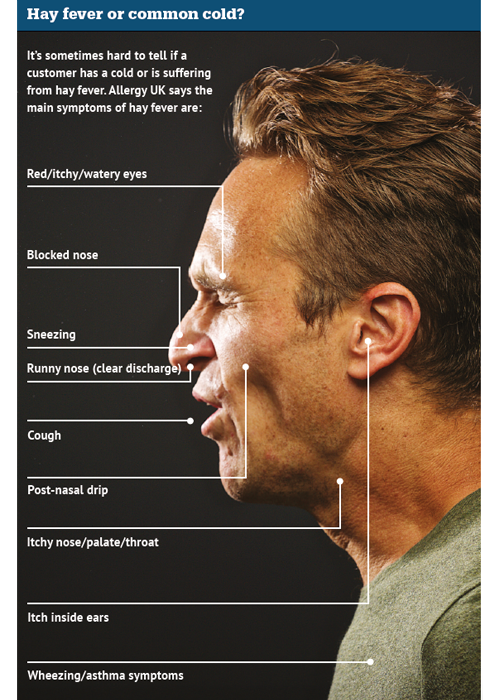 Effect of climate on pollen season
Effect of climate on pollen season
“It very much depends on the weather between late March and mid-May as to how much grass pollen will be produced,” says Beverley Adams-Groom, chief palynologist and pollen forecaster at the University of Worcester. “Rain and warm conditions will allow high pollen production, while cold and dry conditions will lead to lower pollen production. The severity of the season also depends on whether it is warm and dry or cool and wet – the former giving the highest risk.
“The tree pollen season this year will be mild to averagen in severity, compared with last year’s season, which was exceptionally severe. For the main tree pollen season (birch, plane and oak), a slightly earlier onset is expected due to mild conditions so far this year. Birch was likely to start in March in southern and central regions, extending to the rest of the country a couple of weeks later. Plane and oak are likely to start in April.”
Climate change is having an effect on our hay fever season. “We’ve seen some new trends over the last 25 years,” says Dr Adams-Groom. “Most tree pollens are starting a little earlier, especially hazel, which is becoming more severe and lasting longer. Alder pollen is also increasing in severity. Birch pollen is starting earlier and increasing in severity in regions where these trees are popular, such as suburban areas. Oak pollen season is starting earlier but decreasing in duration and severity. Grass pollen season is not showing changes in onset yet, but is decreasing in severity and duration. Climate change is creating more variable pollen seasons. It is driving the trend to earlier starts and decreasing duration and severity. The latter is caused by greater frequency of warm, dry weather in the pollen season.
“This allows pollen to be dispersed quickly and flowering to finish more quickly. In some years, we are seeing the flowers dying in the heat before all the pollen can be released. This leads to shorter, sometimes sharper, seasons. In the future, we expect to see even more increased variability in the seasons.” For a regional pollen forecast for this year, visit University of Worcester Pollen Forecast.
Improve your hay fever category
- “Much of the support for hay fever sufferers is about offering practical tips around living with hay fever,” says Numark’s Naresh Rallmil. “This advice can help customers manage their symptoms. It also offers you the opportunity to transfer potential sales into other categories, such as disinfectants and tissues.”
- “Trusted brands become known to regular sufferers, so make use of these brands on your fixture with multiple facings to help customers locate and navigate the category,” says Cathy Crossthwaite, marketing co-ordinator at Numark. “We recommend a leading brand to help customers navigate the fixture and an own-brand alternative alongside for a value option. Include a range of products that cover different formats and active ingredients.”
- “Keep an eye on product advertising as we enter the season, particularly on TV,” she says. “Advertising will drive sufferers to try a new product, so ensure you have stock available.”
- “Help customers take control of their hay fever by stocking products that will enable them to create their own handy hay fever kit,” says Max Wiseberg, founder of HayMax. “Include one or more natural products, antihistamines, nasal sprays and eye drops. There are many different brands for each type of product, so ensure you stock several to enable customers to find one that works for them.”
- “Make sure the whole pharmacy team is trained on the hay fever range you’re stocking, especially new products,” says AHH’s Simon Mollart. “Make sure you have a wide variety of products as customers want a wide choice. Stock a mix of branded and own-label products that relieve different symptoms and stock both loratadine and certirizine-based products.”
- “Group products within your allergy category by active ingredient then brand, and place generics next to the branded products to highlight potential savings,” he says.
- “Pharmacies need to concentrate on adding value rather than competing on cost with supermarkets,” says pharmacist Sie Ting. “Offer patients a tailored service. I advise my teams to stay up-to-date with the latest information. Make the most of point-of-sale material and ensure information is clearly visible to customers.
Hay fever advice
According to Allergy UK, it’s important to treat hay fever not only because of its effect on quality of life, but because of its links with asthma. People who have hay fever are at increased risk of developing asthma, while many people with asthma also have hay fever. Asthma can be better controlled with fewer hospital admissions if allergic rhinitis is effectively treated.
A simple measure to reduce pollen exposure, says Allergy UK, is to use a nasal allergen balm around the nostrils, which can stop pollen from entering the nose. Nasal rinses with saline solution can be used to wash pollen from the nose and prevent symptoms. These can both be used in conjunction with OTC hay fever remedies, says Allergy UK.
Allergy UK has the following self-help tips for customers with hay fever:
- Monitor pollen forecasts daily and stay indoors, where possible, on high-count days
- Limit time spent in rural areas. Counts are lower at the coast
- On high-count days, shower and wash hair after arriving home and change clothing
- Keep windows closed when indoors, especially early morning and evenings
- Pollen counts tend to be high along roads with grass verges. Make sure your car has a good pollen filter
- Avoid mowing the lawn yourself
- Wear wraparound sunglasses when outdoors to keep pollen out of your eyes. A hat with a broad brim will keep pollen off your face
- Avoid drying clothes outdoors when pollen counts are high
- Keep car windows closed and the air intake on “recirculate” when driving
- Pets carry pollen on their fur. Wipe their coats with a damp microfibre cloth to remove pollen after they’ve been outdoors.
Antihistamines and nasal sprays should be taken regularly to prevent symptoms. It is a common mistake to use these only when symptoms flare up
PollerGEN study aims to redefine forecasts
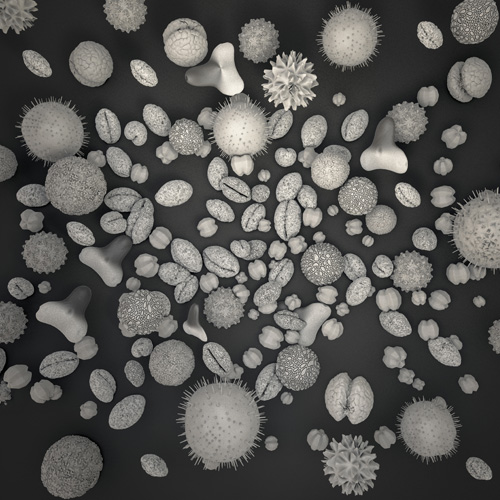 The Natural Environment Research Council’s PollerGEN project team has been working on a way to detect airborne pollen from different species of allergenic grass. It is also developing new pollen source maps and modelling how pollen grains move across landscapes, as well as identifying which species are linked to a worsening of asthma and hay fever.
The Natural Environment Research Council’s PollerGEN project team has been working on a way to detect airborne pollen from different species of allergenic grass. It is also developing new pollen source maps and modelling how pollen grains move across landscapes, as well as identifying which species are linked to a worsening of asthma and hay fever.
The project is using a new UK plant DNA barcode library and environmental genomic technologies to identify complex mixtures of tree and grass pollens from a molecular genetic perspective. By combining this information with source maps and aerobiological modelling, it hopes to redefine how pollen forecasts are measured and reported in the future.
Tailored treatment
As well as taking preventative measures, it’s important to recommend the right type of treatment for customers with hay fever, depending on their symptoms.
“People living with hay fever should aim to start using prevenattive/treatment nasal sprays two weeks before symptoms usually begin and take medication regularly for it to be effective,” says Allergy UK. If a customer has mild-to-moderate intermittent or mild persistent symptoms, you can advise the as-needed use of an intranasal antihistamine or a non-sedating antihistamine tablet. Intranasal antihistamines (azelastine) have a faster onset and are more effective than oral preparations. Oral antihistamines include loratadine and cetirizine. You can recommend an intranasal chromone (sodium cromoglicate) as needed if antihistamine can’t be used. For a customer with moderate to severe persistent symptoms, you can recommend a regular intranasal corticosteroid during the hay fever season. Advise that they may not get the maximum benefit until they’ve been using it for two weeks.
“Antihistamines and nasal sprays should be taken regularly to prevent symptoms,” says Mr Rallmil. “It is a common mistake to use these only when symptoms flare up. Oral antihistamines should be taken regularly for maximum effect.”
Some customers may not realise that they can take certain allergy medications in combination to helptreat all of their symptoms.
“Recommend that customers consider a three-step allergy relief treatment plan – nasal spray, eye drops and tablets – if they experience multiple hay fever symptoms,” says Mr Mollart.
Sie Ting, pharmacist at the Alphega Pharmacy in Hull, says: “New sufferers may have a number of inaccurate ideas about how to treat hay fever, the most common mistake being not taking medication regularly. Other mistakes we see include customers expecting remedies to work immediately, stopping using them when they feel okay and then not taking precautions to try and prevent symptoms.” Nasal sprays with decongestants can be used on the worst days for additional relief, but should not be used regularly.
Antihistamines and corticosteroid nasal sprays often control eye symptoms, but pharmacy teams can recommend eye drops if needed. For severe symptoms, corticosteroid tablets can be taken for a few days alongside a corticosteroid/antihistamine nasal spray. For the most severe cases, allergen immunotherapy can be recommended by an allergy specialist.
Views from the P3pharmacy category panel
Sarina Mughal Day Lewis, London SW1
“This is an important category. Our customers usually know what they want, so we keep a good variety of antihistamines. We have an enhanced PGD for hay fever, so we can prescribe POMs, which is popular. We get asked frequently about children’s hay fever. Clarityn and Zirtek are our best selling antihistamines. Beconase and Puressentiel are the most popular nasal sprays. For children, it’s Piriton. We get a lot of queries from pregnant women and usually recommend Prevalin. We display hay fever information on our digital screens. It’s important for your team to be up-to-date about PGDs and to have plenty of leaflets available on treatment.”
Selina Gill Rowlands Pharmacy, Church Green, Redditch
“This is one of busiest times of the year. ‘Is there anything better I can take?’ is the question I get asked most during hay fever season. Often, patients are unsure whether they are self-medicating in the most effective way and require reassurance and advice. I often see patients steering away from branded antihistamines to the cheaper generics, cetirizine being the most popular. With more and more CCGs not supporting prescribing of OTC medicines, we have seen a huge rise in sales of hay fever medicines over the past two years. Pharmacists must be ready to counsel patients on various treatments and offer an array of products.”
Jaimini Modi Keencare Pharmacy, Harrow
“Most hay fever sufferers know what they need, but on the rare occasion patients present with symptoms for the first time, we recommend nasal sprays, eye drops or oral formulations. These include the Piriton range and other brands such as Clarityn or Benadryl. Other patients benefit from generic cetirizine or loratadine. We also offer Opticrom to help ease itchy/watery eyes. We display these products in our window just before the summer season to help sales. There are opportunities to grow this category by not restricting promotionto the summer months. Hay fever and allergies can occur non-seasonally and sales of these products can be made all year round."

